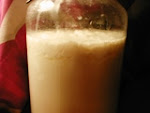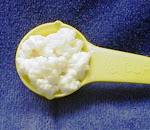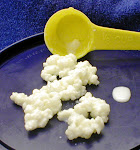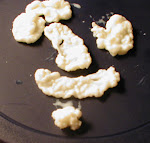It does seem like it would be a simple thing to ferment with milk kefir grains.... put the grains in, take the grains out, drink the kefir and it is easy once you get the basics and start running on autopilot.
I've heard a lot of misinformation about brewing milk kefir but none of it is serious and you can't go too far wrong if you use a little common sense; but, sometimes when something is so new to a person it is so foreign that it is hard to see clearly; so, here I am again trying to write a very clear instructional guide to fermenting with milk kefir grains.
There are certainly no rules or authority when you are dong this; you can basically brew kefir anyway that makes you happy, anyway you like it. There are no kefir police, if you want to ferment for optimal probiotic benefit you may do that; you may just want a good tasting drink that is healthful or at least one that won't hurt you too much; you could do that or something anywhere in between.
Here are the basics of the thing
Milk kefir is generally fermented at a ratio of between 7 to 14 parts milk to kefir grains by volume. That means you measure your grains and if they measure one ounce you may ferment with 7 to 14 ounces of milk. How much milk (between 7 to 14 ounces) is determined eventually by you according to how active your grains are at the time, the temperatures in the fermenting environment, how you like your kefir to come out, etc. It might be good to start at a 10 to 1 ratio and see how it goes and how you like it like that and adjust from there. How long you ferment is also up to you but there are things to keep in mind.
I've read other directions that say kefir is done when it separates or when the kefir result in the jar makes rivers on it's sides (if you can picture that.) Well; it is done when you say it is done; but, for optimal benefits a long fermentation is necessary; so, all the reactions that place may take place. Kefir strains work in a certain order. The first reaction from the strains create an acidic environment, the next start to digest the lactose, then the yeasts begin and finally the smelly reactions begin, all these reactions don't happen in 18 hours.
You put your grains in the milk and they will float barely sticking up above the surface. Depending on whatever, with in hours the grains will send out their strains and gather up milk around themselves, they will thicken from the kefiran being produced within. Don't forget to mix or stir your fermenting kefir as much as possible or just whenever you think about it. It will come to a point where the grains will get so thick that your plastic stirrer will stand and not fall due to the thickness of the grains at the top of the mixture. You keep mixing
The grains will eventually stop swelling and return to normal size as this reaction is now over and another has begun. The mixture has come to a point where it will not separate anymore and at this point you can also call it done. What I do here is give it another few hours to get to the point where much of the lactose is digested and all of the reactions have taken place and I have optimal benefits from my fermentation.
Someone wrote me and said their kefir smells like old gym socks. That is when real full tilt max kefir is done. You don't have to do it this way; but, this is full benefit kefir, that is a probiotic soup. Any place in between here is still an excellent healthy probiotic, it just depends on how far you are able to or want to take it... if you have a child and the child doesn't like the taste of a full fermentation, then what good is it, if you can do an 18 hour fermentation and add some fruit to it and the child likes it, then you are better off.
Here is what you do and what you don't do
When you get your kefir grains from the mail put the whole package in new milk, you are not gonna drink this first batch anyhow. put them in a low ratio milk to kefir grains like 5 or 6 parts milk to grains as the grains may be weak anyway. do a 24 hour fermentation and see how it goes. The grains should be ready to go after this one cycle and you can drink the next.
Try and get a jar that you can put your whole hand in so you can clean every part of it well. Use more elbow grease than soap or no soap at all. You don't have to use soap every time if you scrub in very hot water and then rinse right away in very cold water. Foreign bacteria thrive in the temperature in between,be aware of that. Kefir can more or less take care of their own defense from foreign bacteria, do not wash them or store them in water. Don't even wash them in evev in milk. When you strain them be gentle and don't do a good job of it, leave some of the sticky stuff, the grains are comfortable in the sticky stuff.
What the grains don't like and can't defend against is chemicals. Watch out for soap residue, watch out for the chemicals in the water, chlorine, fluoride, arsenic, mercury, if you rinse your jar in water, place it upside down on a paper towel to dry and get a spray bottle and fill it with distilled vinegar. Spray the bottles and the utensils with the vinegar and once again place the jars upside down to dry.
Use a glass jar, use a plastic strainer or if you have to use stainless steel but be gentle. Only ferment with milk, do not put in sugar or fruit while you still have the grains in there. You can do a secondary fermentation when you take the grains out; leave the result on the counter and then you can put in whatever you want but remember if you put in anything that contains any kind of sugar the strains of kefir like the sugar too and may stop digesting lactose in favor of what you put in.....
You can ferment soy, rice, and any kind of nut milk but remember that milk kefir grains need mammal milk and if you don't cycle them back to mammal milk they will weaken and eventually die
You will need to check the volume of the grains as they grow and reproduce in order to create a proper ratio from you milk to your grains. Milk kefir grains naturally grow in size and large grains are inefficient so you may need to pull apart some of the large grains every other week or so. an efficient grain should be no bigger than a jumbo pistaccihio nut.
Flat grains are a natural occurrence in you kefir colony. Sometimes they right themselves back into proper grains but sometimes they don't and they can grow very large, they can have a very large surface area and they can quicken fermentation to a point that is undesirable so you will have to go into the colony and throw them out. They can grow to the size of your hand,
Forget about dehydrating or freezing you grains for storage. Leave them in the refrigerator in milk if you have to store them. If you have to store them more than a month, throw them away and buy new ones. That is what I am here for.
Get it down pat and then just enjoy it
For a good time see the Bacteriapimp or and visit Homemade Probiotics and to learn about the lastest in metabolic balancing machines visit metabolic Balancers













No comments:
Post a Comment